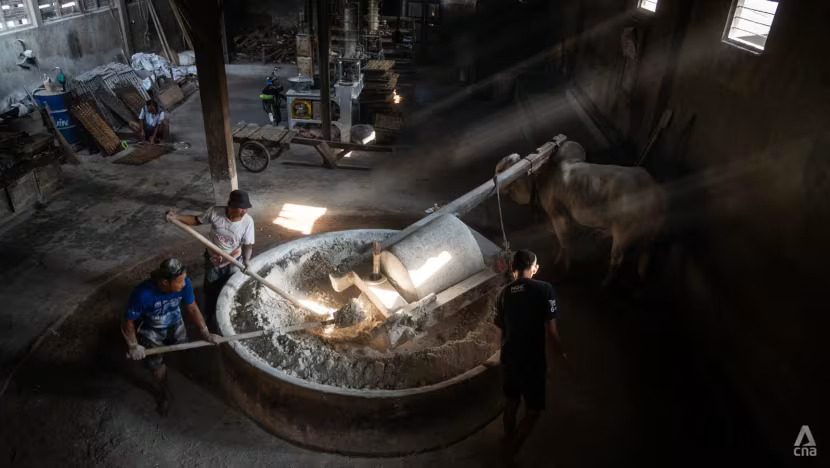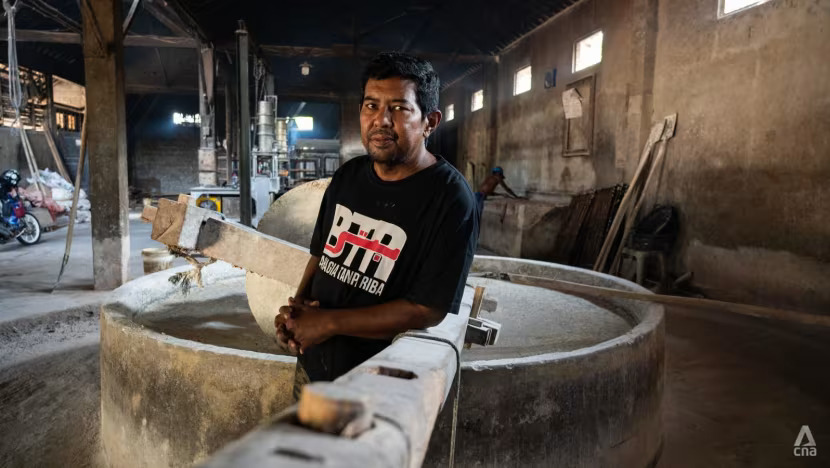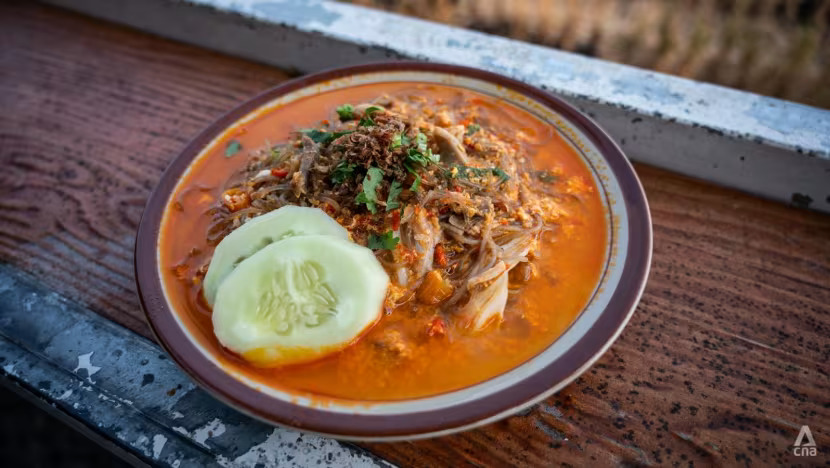
BANTUL, Indonesia (CNA) – Nestled within weathered walls, time seems suspended at an 80-year-old noodle factory in southern Java. In one corner, an ox guides a wooden beam to turn a one-tonne millstone over dried cassava in a concrete basin.
Meanwhile, workers in another corner place dough and noodles on bamboo shelves inside a wood-fired chamber, steaming them for 90 minutes.
Located in Bantul regency of Indonesia’s Yogyakarta province, the factory employs ancient production techniques. The introduction of several hydraulic presses represents its only modern touch.
According to factory owner Yasir Feri Ismatrada, 49, these machines enhance safety compared to the risky manual press used in the past.
Before the old press was retired a few years ago, workers had to jump and hold on to its lever, using their weight to compress the dough inside. When the wooden lever became slippery, workers often fell and sprained their ankles or hit their head on the hard factory floor.
The cassava noodles produced are called “mie lethek”, which literally means “dirty noodles” because of their dull brown colour. Compared to other types of noodles such as bihun or rice noodles, mie lethek is more savoury and has a chewier texture.
Despite its rich history, mie lethek nearly disappeared from Yogyakarta’s food landscape when instant noodles became popular from the 1970s.
Mr Yasir’s Mie Garuda factory was among those that had to close shop until mie lethek saw a revival in the early 2000s.
By then, he was only one of a handful of cassava noodle makers who heeded the renewed interest and restarted the business; others had given up due to the complexity of the manufacturing process.

Mr Yasir’s factory is now one of only two mie lethek factories in Indonesia still using traditional methods and techniques.
Mr Yasir’s grandfather, Umar Bisri Nahdi, is credited as the creator of mie lethek.
Mr Umar was preaching Islam in Bantul in the 1930s and 1940s when he noticed that people there were starving. At the time, the Dutch colonial rulers controlled virtually every type of food with the exception of cassava, also known as tapioca, which they saw little economic value in.
The preacher, who acquired knowledge of noodle making from his wife’s family, who was ethnic Chinese, began to produce noodles from cassava to feed the poor.
The noodles proved to be so popular that in 1940 – when Indonesia was still known as the Dutch East Indies – Mr Umar converted his house into a makeshift factory, employing locals in his neighbourhood to help out.
Soon, mie lethek became a staple in most Bantul households and roadside vendors began selling them.
With the arrival of cheap and ubiquitous instant noodles in the 1970s and 1980s, mie lethek manufacturers found themselves unable to compete. Mr Yasir’s family closed the factory in 1982.
Two decades later, health and food safety concerns led to a turnaround in mie lethek’s fortunes.

Mr Yasir revived the factory in 2002 after his uncles convinced him that “the noodles we were making were healthy noodles”.
Indonesia was also gripped with news of borax and formaldehyde poisoning. A series of cases where people died after consuming food laden with preservatives and additives prompted widespread interest in organic food.
“Our noodles are completely organic. Our cassava (sourced from farmers) doesn’t involve pesticides. We don’t use preservatives or additives and our (production) process is very traditional,” he said.
Mie lethek continues to be a hit with health-conscious consumers.
One of the establishments Mr Yasir supplies to is Mbah Mendes, a restaurant run by businessman Hanny Susilo. Mr Hanny said he was drawn to the noodles’ complex taste, labour-intensive production process and rich history when he set up his eatery exclusively serving mie lethek dishes in 2014.
“This is a noodle that is unique to Bantul. Out of all the noodles out there, this is the hardest to make because it still uses traditional methods,” the 64-year-old told CNA at his restaurant in Yogyakarta city.
The noodles received another massive boost in 2017 when former United States president Barack Obama, who spent four years living in Indonesia as a child, visited the province on a family holiday.
Among the dishes the Obamas savoured during their 10-day trip to Indonesia was mie lethek which, until then, was not widely known outside of Yogyakarta.
“Restaurants were fighting to get their hands on mie lethek,” Mr Hanny said.

“If it weren’t because I know Mr Yasir personally, my restaurant would struggle to secure a steady supply of mie lethek. It was suddenly that popular.”
Although demand is surging, it is hard for Indonesia’s two surviving mie lethek factories to increase production.
“Because we do almost everything manually, the production process takes longer,” said Mr Yasir.
Each month, his Mie Garuda factory produces up to 10 tonnes of cassava noodles, which is barely enough to meet demand in the province, let alone the rest of the archipelago.
Mr Yasir estimates demand is four times what he can produce but, to keep the noodles affordable, he has maintained its price at IDR80,000 (USD4.90) for five kilogrammes.
He said he is not planning to increase output.
One reason is that there are not many experienced artisans around today.
He believes that replacing these skilled workers with machines and automating some of the processes would mean sacrificing quality.
The ox-driven mills used to grind dried cassava into flour have also been recognised as a national intangible cultural heritage by the Indonesian ministry of education and culture for the past five years. This spurs Mr Yasir to do all he can to keep the age-old practice alive.
Traditional methods are “quite laborious”, but “if we use machines… replace the millstone with metal ones for example, the taste will be different”, he said.
“This is why we try to keep things the way they are.”





